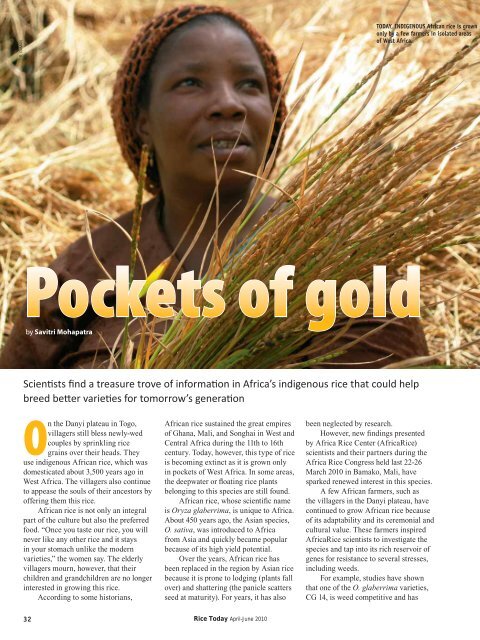R. RAMANTODAY, INDIGENOUS African rice is grownonly by a few farmers <strong>in</strong> isolated areas<strong>of</strong> West Africa.<strong>Pockets</strong> <strong>of</strong> <strong>gold</strong>by Savitri MohapatraSciensts nd a treasure trove <strong>of</strong> <strong>in</strong>formaon <strong>in</strong> Africa’s <strong>in</strong>digenous rice that could helpbreed beer variees for tomorrow’s generaonOn the Danyi plateau <strong>in</strong> Togo,villagers still bless newly-wedcouples by spr<strong>in</strong>kl<strong>in</strong>g rice<strong>gra<strong>in</strong></strong>s over their heads. Theyuse <strong>in</strong>digenous African rice, which wasdomesticated about 3,500 years ago <strong>in</strong>West Africa. The villagers also cont<strong>in</strong>ueto appease the souls <strong>of</strong> their ancestors by<strong>of</strong>fer<strong>in</strong>g them this rice.African rice is not only an <strong>in</strong>tegralpart <strong>of</strong> the culture but also the preferredfood. “Once you taste our rice, you willnever like any other rice and it stays<strong>in</strong> your stomach unlike the modernvarieties,” the women say. The elderlyvillagers mourn, however, that theirchildren and grandchildren are no longer<strong>in</strong>terested <strong>in</strong> grow<strong>in</strong>g this rice.Accord<strong>in</strong>g to some historians,African rice susta<strong>in</strong>ed the great empires<strong>of</strong> Ghana, Mali, and Songhai <strong>in</strong> West andCentral Africa dur<strong>in</strong>g the 11th to 16thcentury. Today, however, this type <strong>of</strong> riceis becom<strong>in</strong>g ext<strong>in</strong>ct as it is grown only<strong>in</strong> pockets <strong>of</strong> West Africa. In some areas,the deepwater or float<strong>in</strong>g rice plantsbelong<strong>in</strong>g to this species are still found.African rice, whose scientific nameis Oryza glaberrima, is unique to Africa.About 450 years ago, the Asian species,O. sativa, was <strong>in</strong>troduced to Africafrom Asia and quickly became popularbecause <strong>of</strong> its high yield potential.Over the years, African rice hasbeen replaced <strong>in</strong> the region by Asian ricebecause it is prone to lodg<strong>in</strong>g (plants fallover) and shatter<strong>in</strong>g (the panicle scattersseed at maturity). For years, it has alsobeen neglected by research.However, new f<strong>in</strong>d<strong>in</strong>gs presentedby Africa Rice Center (AfricaRice)scientists and their partners dur<strong>in</strong>g theAfrica Rice Congress held last 22-26March 2010 <strong>in</strong> Bamako, Mali, havesparked renewed <strong>in</strong>terest <strong>in</strong> this species.A few African farmers, such asthe villagers <strong>in</strong> the Danyi plateau, havecont<strong>in</strong>ued to grow African rice because<strong>of</strong> its adaptability and its ceremonial andcultural value. These farmers <strong>in</strong>spiredAfricaRice scientists to <strong>in</strong>vestigate thespecies and tap <strong>in</strong>to its rich reservoir <strong>of</strong>genes for resistance to several stresses,<strong>in</strong>clud<strong>in</strong>g weeds.For example, studies have shownthat one <strong>of</strong> the O. glaberrima varieties,CG 14, is weed competitive and has32 Rice Today April-June 2010
good resistance to iron toxicity, drought,nematodes, waterlogg<strong>in</strong>g, and majorAfrican rice diseases and pests. It seemsto adapt to acid soil with low phosphorusavailability.“Such multiple resistance to<strong>in</strong>digenous constra<strong>in</strong>ts is a highlydesirable character for rice cultivated<strong>in</strong> the ra<strong>in</strong>fed ecology <strong>in</strong> West Africaby resource-poor farmers, who cannotafford to adopt <strong>in</strong>tensive agronomicmeasures aga<strong>in</strong>st such constra<strong>in</strong>ts,” saidDr. Moussa Sié, senior rice breeder andcoord<strong>in</strong>ator <strong>of</strong> the Rice Breed<strong>in</strong>g TaskForce <strong>of</strong> AfricaRice.That is why AfricaRice scientistDr. Monty Jones and his team selectedCG 14 when they decided to cross O.glaberrima with O. sativa <strong>in</strong> the 1990sto develop productive rice varieties thatcan adapt to African conditions. Theysucceeded <strong>in</strong> break<strong>in</strong>g the natural barrierthat makes it difficult for the two speciesto cross. This was the genesis <strong>of</strong> the NewRice for Africa (NERICA). The bestNERICA varieties comb<strong>in</strong>e the stresstolerance <strong>of</strong> O. glaberrima with the highyield potential <strong>of</strong> O. sativa.“However, there are still gapsbetween the NERICA varieties andO. glaberrima <strong>in</strong> relation to resistanceto some local constra<strong>in</strong>ts,” Dr. KoichiFutakuchi, AfricaRice ecophysiologist,observes.AfricaRice therefore started tosystematically characterize its entire O.glaberrima collection <strong>of</strong> 2,500 samples<strong>in</strong> 2009. A special effort is be<strong>in</strong>gmade to screen for major diseases andenvironmental stresses such as acidity,iron toxicity, cold, and sal<strong>in</strong>ity.Expla<strong>in</strong><strong>in</strong>g this comprehensiveeffort, Dr. Kayode Sanni, coord<strong>in</strong>ator <strong>of</strong>the International Network for GeneticEvaluation <strong>of</strong> Rice for Africa (INGER-Africa), says that until now only a fewaccessions <strong>of</strong> O. glaberrima have beenused <strong>in</strong> the breed<strong>in</strong>g programs.“By characteriz<strong>in</strong>g our O.glaberrima collection <strong>in</strong> our genebank,we may f<strong>in</strong>d new O. glaberrima l<strong>in</strong>eswith better traits than the current parentall<strong>in</strong>es <strong>of</strong> NERICA,” Dr. Sanni says.AfricaRice is also chang<strong>in</strong>g thebreed<strong>in</strong>g concept as well as breed<strong>in</strong>gprocedures to develop new <strong>in</strong>terspecificvarieties. “The new concept for<strong>in</strong>terspecific breed<strong>in</strong>g between O.AfricaRice upland ricebreeder Dr. Mandé Semonlooks at the new ricel<strong>in</strong>es developed fromOryza glaberrima.glaberrima and O. sativa is to comb<strong>in</strong>ethe adaptability <strong>of</strong> O. glaberrima tolocal environments with the optimalconjunction <strong>of</strong> the best traits <strong>of</strong> the twospecies <strong>in</strong> relation to yield<strong>in</strong>g ability,”says Dr. Futakuchi.Studies made by Dr. Futakuchiand his colleagues show that the O.glaberrima parent <strong>of</strong> the upland NERICAvarieties, CG 14, even produced morepanicles than the “panicle-numbertype” high-yield<strong>in</strong>g O. sativa varieties,although its <strong>in</strong>dividual panicle wassmaller. The <strong>in</strong>troduction <strong>of</strong> such anextraord<strong>in</strong>ary trait may favor yield<strong>in</strong>gability.Such studies <strong>in</strong>creas<strong>in</strong>gly recognizethe “need to exploit the treasure trovethat is <strong>in</strong> African rice germplasm,” asAfricaRice upland rice breeder Dr.Mandé Semon puts it.Dr. Semon is lead<strong>in</strong>g the effort toobta<strong>in</strong> <strong>in</strong>terspecific hybrids that haveBamakoDanyiplateauCentral and Western Africa.K. OROUmore O. glaberrima genes <strong>in</strong> the genomethan the current NERICA varieties,which were developed from backcross<strong>in</strong>gto an O. sativa parent. “We are us<strong>in</strong>g<strong>in</strong>terspecific bridge l<strong>in</strong>es <strong>in</strong> crosseswith O. glaberrima and O. barthii andno backcross<strong>in</strong>g has been done withthe O. sativa parent,” he expla<strong>in</strong>s. “Theprogenies will be ready for field test<strong>in</strong>gsoon.”To better exploit the assets <strong>of</strong> O.glaberrima without be<strong>in</strong>g hampered bythe sterility problems <strong>of</strong> hybridizationwith another species, AfricaRicescientists have begun work<strong>in</strong>g on the<strong>in</strong>traspecific breed<strong>in</strong>g <strong>of</strong> O. glaberrimaand are tak<strong>in</strong>g steps to develop plantsthat are less prone to lodg<strong>in</strong>g andshatter<strong>in</strong>g.S<strong>in</strong>ce O. glaberrima had beenconsidered to have generally low yieldpotential, <strong>in</strong>terspecific hybridization withO. sativa, which has high yield potential,was a major method <strong>in</strong> us<strong>in</strong>g this species.However, AfricaRice breeders now th<strong>in</strong>kthat O. glaberrima can potentially yield5–6 tons per hectare, which is sufficientfor ra<strong>in</strong>fed rice ecosystems <strong>in</strong> Africa.Initial results from cross<strong>in</strong>g differenttypes <strong>of</strong> O. glaberrima also show thatcompletely different sets <strong>of</strong> genes areresponsible for tolerance <strong>of</strong> submergence,rice yellow mottle virus, and phosphorusdeficiency <strong>in</strong> soils from those <strong>in</strong> O.sativa.Some new products will likelybe derived us<strong>in</strong>g molecular breed<strong>in</strong>gapproaches, through collaborative effortswith the International Rice ResearchInstitute and Ch<strong>in</strong>ese Academy <strong>of</strong>Agricultural Sciences. AfricaRicescientists are already us<strong>in</strong>g this approachto <strong>in</strong>troduce resistance to disease andother stresses <strong>in</strong>to some <strong>of</strong> Africa’s mostpopular rice varieties.With Cornell University <strong>in</strong> theU.S., a s<strong>in</strong>gle nucleotide polymorphism(SNP) chip is be<strong>in</strong>g developed basedon core collections <strong>of</strong> O. glaberrimaand O. barthii. This chip can efficientlyanalyze African germplasm and screen<strong>in</strong>terspecific progenies for desirabletraits.“We have new products <strong>in</strong> thepipel<strong>in</strong>e for Africa’s rice farmers,particularly those who want to cont<strong>in</strong>ueto grow African rice–like those <strong>of</strong> theDanyi plateau,” says Dr. Sié.Rice Today April-June 201033

















